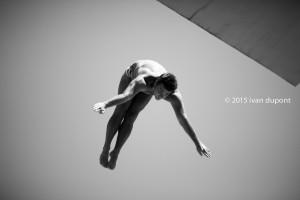Alteration. Risk-Taking. Bravery. Curiosity. Breakthrough.

When you think of innovation, these are the synonyms that come to mind. These characteristics are intimately related to platform diving – a sport I took up at the age of 40.
That was four years ago and I now dive competitively around the world. I also have a passion for innovation, in all its forms, and I push myself to work and think innovatively. These two pursuits have more in common than you may think. In fact, I’ve come up with six ways that being a competitive platform diver and striving to be more innovative share a common thread.
Stay Curious
I became inspired to try diving by observing my daughter. As I smelled the chlorine from the pool and watched her climb the platform I thought, “What does that feel like? I’d like to find out.” Soon after, I signed up for my first master class and got started. Innovation works like that too: it is driven by curiosity. As Einstein famously said, “I have no special talent beyond being passionately curious.” Curiosity drives us to see connections. The Swiss Engineer George de Mestral didn’t set out to discover Velcro when he went for a walk in the woods with his dog. He just observed that the burrs from plants got stuck in his trouser legs and his dog’s fur. His curiosity led him to investigate and – voila – he created an innovative new material and pervasive Velcro was born.
Focus on Execution
Theodore Levitt, an economist and professor at Harvard Business School said, “Creativity is thinking up new things. Innovation is doing new things.” Many people believe that innovation is all about ideas, when it is actually a good deal about process and delivery. As Garry Lyons, chief innovation officer for MasterCard explains, “some people think that all it takes is to put a few geeks in a room with whiteboards and Red Bull to brainstorm, and then expect almost magical results…but it’s not suitable for all forms of innovation and it’s certainly not sustainable.” How does this relate to the world of platform diving? Consider Matthew Mitcham, an Australian who developed an innovative new dive – a sensational two and a half back somersault featuring two and a half twists. Coming up with the dive was just the beginning. Mitcham perfected and delivered it at the 2008 Summer Olympics in Bejing, producing the highest scoring dive in Olympic history. Ideation + execution = innovation.
Be a Little Crazy
Last summer I spent one week of my holiday at a diving camp where I trained for five hours each day. My wife told me I was crazy. However, in diving and innovation, being crazy or different or offbeat often produces the best results. This was the approach we took at Cisco with a recent partner marketing campaign. To incentivize partners to compete for a trip to the Seychelles, we developed a Twitter-based campaign called ‘Wish You Were Here’ (#WYWH2015). Partners earned points by posting photos and videos on Twitter, responding to challenges, and following clues for rewards. This social media based campaign was very different than anything we had attempted before. It turned out to be a big hit. A healthy competition grew among the partners with the added benefit of making them comfortable using Twitter, a valuable skill they can apply to their own social selling programs.
Keep Making Modifications
The angle of a wrist, the point of a toe, an extra breath. Slight modifications in diving techniques can deliver huge results. It’s the same for innovation. It’s not about the moment of brilliance or the single epiphany. Innovation comes in baby steps, through trial and error. As Scott Berkun, author of “The Myths of Innovation,” explains, “When you hear a story about a flash of insight, the useful questions to ask are 1) how much time the creator spent working before the flash happened, 2) how many ideas from other people did they reuse and 3) how much work did they do after the flash to make the idea successful.”
Expect Some Pain
In my four years of platform diving I have made lots of mistakes. Many of them hurt! Yet there is success in failure because I always learn something. In a Forbes article, Jacob Morgan explains that failure is a powerful competitive advantage because the lessons learned encourage innovation. Some companies even embrace this approach. P&G has their “heroic failure award.” TATA has a “dare to try award,” and Supercell, the gaming company behind Clash of Clans, opens a bottle of champagne every time a game fails. Google X, an innovation lab within Google, rewards their employees for failure, and so do many other companies. To be successful, you have to keep working through the pain.
Find Your Team
We think of Steve Jobs, Bill Gates, and Leonardo Da Vinci as lone geniuses who made innovation happen all on their own. This is rarely the case. Innovation requires human interaction and collaboration. The same is true for diving. Even though I stand alone on the platform, I am backed by a community of other divers who train with me, give feedback, and act as cheerleaders. Success couldn’t happen in any other way.
So what’s the takeaway? Innovative thinking, like excellence in platform diving, does not just happen. Success is born through hard work, the right conditions, and a willingness to persevere.
How do you spark innovation? I’d love to hear your ideas.

CONNECT WITH US